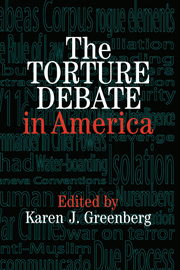Book contents
- Frontmatter
- Contents
- Acknowledgments
- List of Contributors
- Introduction: The Rule of Law Finds Its Golem: Judicial Torture Then and Now
- THE ISSUES
- ESSAYS
- Section One: Democracy, Terror and Torture
- 1 Liberalism, Torture, and the Ticking Bomb
- 2 How to Interrogate Terrorists
- 3 Torture: Thinking about the Unthinkable
- 4 The Curious Debate
- 5 Is Defiance of Law a Proof of Success? Magical Thinking in the War on Terror
- 6 Through a Mirror, Darkly: Applying the Geneva Conventions to “A New Kind of Warfare”
- 7 Speaking Law to Power: Lawyers and Torture
- 8 Torture: An Interreligious Debate
- Section Two: On the Matter of Failed States, The Geneva Conventions, and International Law
- Section Three: On Torture
- Section Four: Looking Forward
- RELEVANT DOCUMENTS
- AFTERTHOUGHT
- Index
1 - Liberalism, Torture, and the Ticking Bomb
Published online by Cambridge University Press: 05 August 2012
- Frontmatter
- Contents
- Acknowledgments
- List of Contributors
- Introduction: The Rule of Law Finds Its Golem: Judicial Torture Then and Now
- THE ISSUES
- ESSAYS
- Section One: Democracy, Terror and Torture
- 1 Liberalism, Torture, and the Ticking Bomb
- 2 How to Interrogate Terrorists
- 3 Torture: Thinking about the Unthinkable
- 4 The Curious Debate
- 5 Is Defiance of Law a Proof of Success? Magical Thinking in the War on Terror
- 6 Through a Mirror, Darkly: Applying the Geneva Conventions to “A New Kind of Warfare”
- 7 Speaking Law to Power: Lawyers and Torture
- 8 Torture: An Interreligious Debate
- Section Two: On the Matter of Failed States, The Geneva Conventions, and International Law
- Section Three: On Torture
- Section Four: Looking Forward
- RELEVANT DOCUMENTS
- AFTERTHOUGHT
- Index
Summary
TORTURE USED TO BE INCOMPATIBLE WITH AMERICAN VALUES. OUR BILL of Rights forbids cruel and unusual punishment, and that has come to include all forms of corporal punishment except prison and death by methods purported to be painless. We Americans and our government condemn states that torture; we grant asylum or refuge to those who fear it. The Senate ratified the Convention Against Torture, Congress enacted anti-torture legislation, and judicial opinions spoke of “the dastardly and totally inhuman act of torture.”
Then came September 11. Less than a week later, a feature story reported that a quiz in a university ethics class “gave four choices for the proper U.S. response to the terrorist attacks: A.) execute the perpetrators on sight; B.) bring them back for trial in the U.S.; C.) subject the perpetrators to an international tribunal; or D.) torture and interrogate those involved.” Most students chose A and D – execute them on sight and torture them. A few days later, another news article – this one about the burden that terrorism places on religious leaders – reported that clergy thought the question of whether to torture terrorists was one they would certainly have to guide their congregations through. Six weeks after September 11, news articles reported that frustrated FBI interrogators were considering harsh interrogation tactics, and the New York Times reported that torture had become a topic of conversation “in bars, on commuter trains, and at dinner tables.”
- Type
- Chapter
- Information
- The Torture Debate in America , pp. 35 - 83Publisher: Cambridge University PressPrint publication year: 2005
- 13
- Cited by



